Are you a plant enthusiast who loves elephant ear plants? These beautiful plants are known for their large, stunning leaves that resemble an elephant’s ear, making them a popular choice for indoor and outdoor decoration.
However, as with any plant, these plants are not immune to problems. The elephant ear plant drooping is one of the most common issues that we owners face while growing.
If you’re reading this article, chances are you’re experiencing this problem and are looking for a solution.
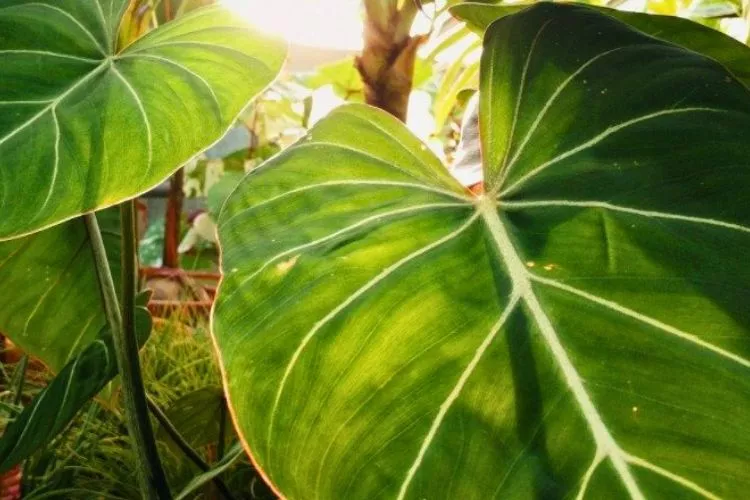
Don’t worry; you’re not alone. Drooping elephant ear leaves can be a frustrating experience, but the good news is that it’s usually fixable.
In this article, we’ll explore the possible causes of elephant ear plant drooping and provide practical solutions to help you revive your plant.
We’ll also share pro tips to prevent the problem from happening in the future. So let’s dive in and help you keep your elephant ear plants healthy and beautiful.
Table of Contents
Possible Causes of Elephant Ear Plant Drooping
Finding the root of the issue is the first step in fixing droopy elephant ear plants. Your elephant ear plant may be sagging for several reasons, and you’ll need to get to the bottom of the issue before you can fix it.
Watering problems, environmental variables, nutrient shortage, and insect invasions are some potential reasons for elephant ear plant drooping that we’ll discuss below.
We will give you concrete instances and graphic aids to help you zero in on the source of the issue.
Watering Issues
Watering issues are a common cause of elephant ear plant drooping. Here are the 2 most common water problems that can occur:
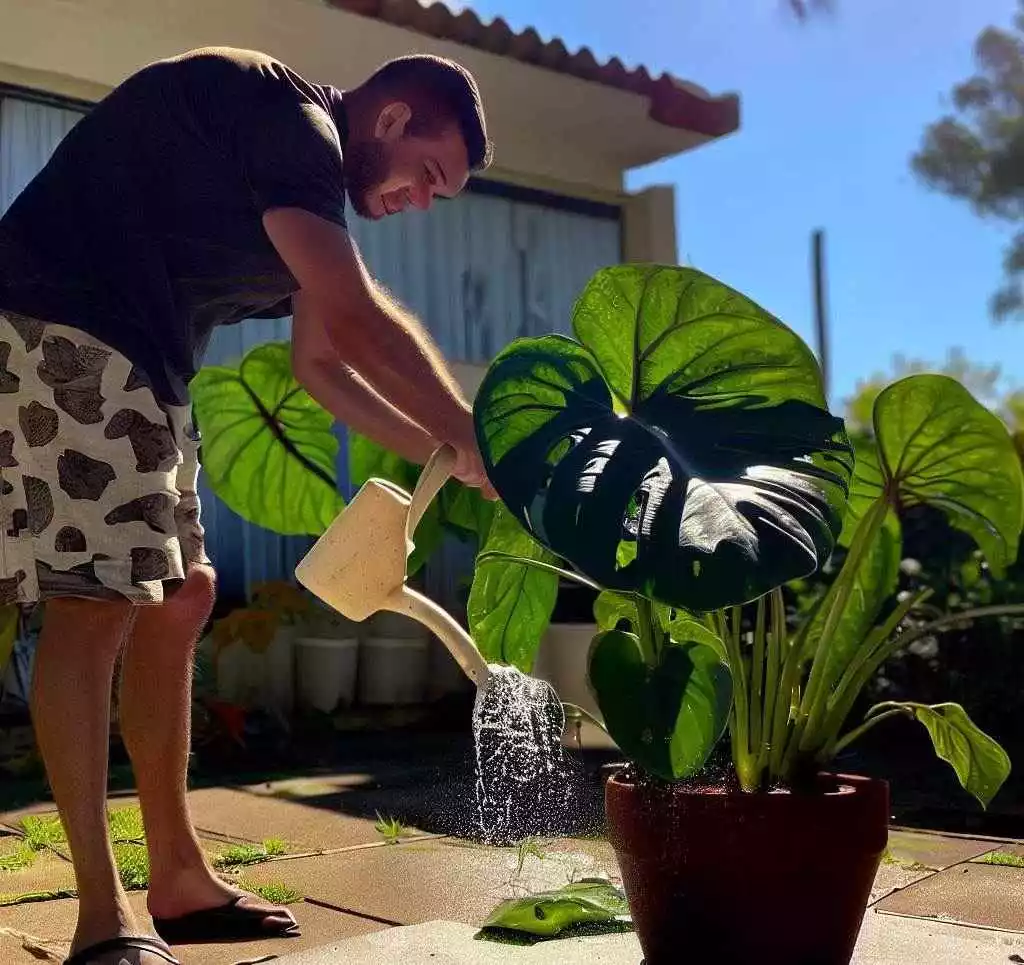
Insufficient water
Insufficient water can cause elephant ear plant leaves to hang because the plant is not getting enough water to support its growth and health.
Water is essential for a plant’s survival because it transports nutrients from the soil to the leaves, where they are then used for photosynthesis.
When a plant lacks this water, it can’t produce enough energy to support its metabolic processes, leading to droopy leaves and slowed growth.
For example, if you have an indoor elephant ear plant that is not watered enough, its leaves may start to droop and wilt because the plant cannot produce enough energy to maintain its leaves’ turgor pressure. The plant’s soil may also feel dry to the touch.
Overwatering
On the other hand, an excess of water can cause elephant ear plant leaves to droop because the roots become waterlogged and cannot absorb nutrients properly. Water is essential for a plant’s survival, but too much can be detrimental because it can fill the spaces between soil particles and prevent roots from absorbing oxygen.
The excess water suffocates the root system and leads to root rot, which can cause droopy leaves and eventual death.
For example, if you have an outdoor elephant ear plant planted in a pot without adequate drainage holes, it may become overwatered after heavy rainfall. This will clog up the soil and start to rot out the roots.
Environmental Factors
Environmental factors like lighting and temperature can also contribute to elephant ear plant drooping. Let’s have a look at how they cause their damage:
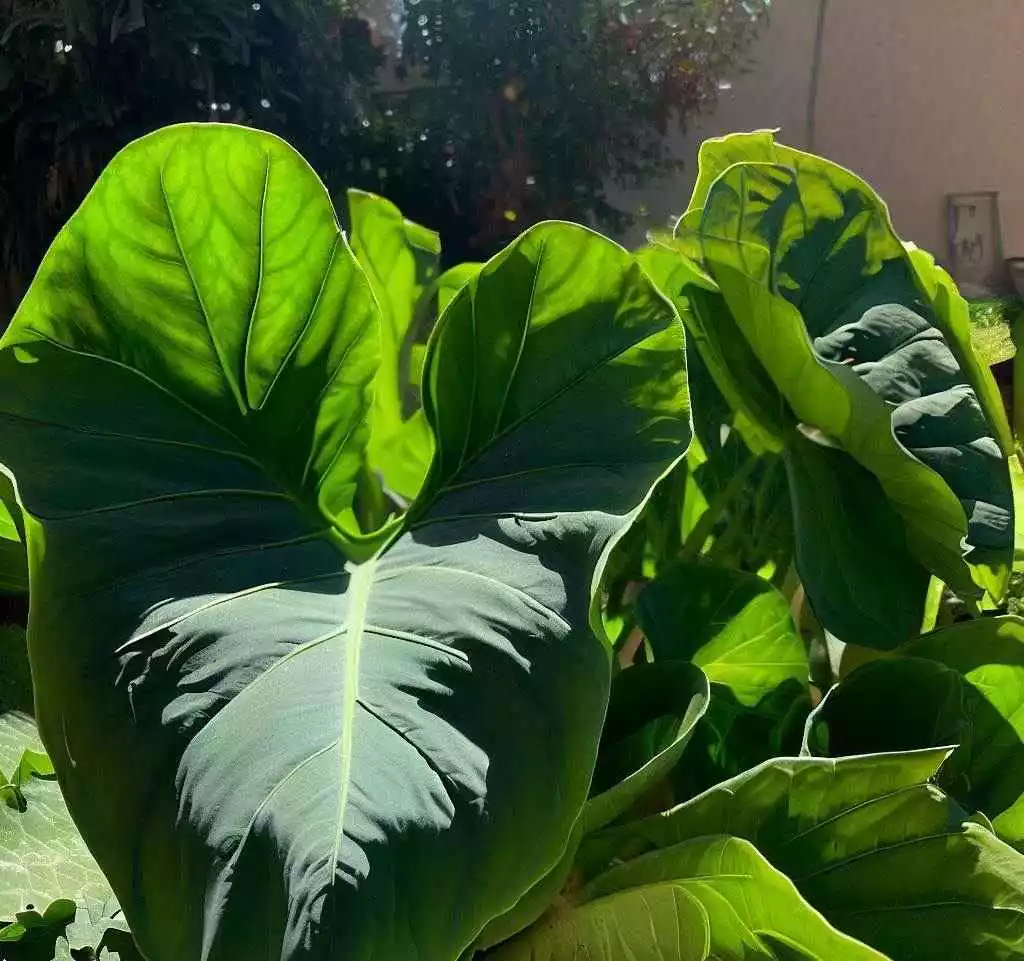
Improper Lighting
Improper lighting can cause elephant ear plant leaves to droop because the plant is not receiving enough or too much light, which can affect its photosynthetic processes.
Elephant ear plants require bright, indirect light to thrive, but too much direct sunlight can scorch their leaves, causing them to droop and wilt.
Temperature Stress
Temperature stress can also cause elephant ear plant leaves to droop. Elephant ear plants prefer warm temperatures between 65-85°F (18-29°C), and they can become stressed if the temperature drops too low or rises too high.
Temperature stress can affect the plant’s metabolic processes, causing the leaves to droop and wilt.
For example, if you have an indoor elephant ear plant near a drafty window, its leaves may start to droop and wilt because of temperature fluctuations. Alternatively, if the plant is placed in a room that is too hot, its leaves may also become droopy.
Nutrient Deficiency
A lack of or too many nutrients can throw your plant out of whack. Let’s look at which ones can cause your elephant plant’s leaves to droop.
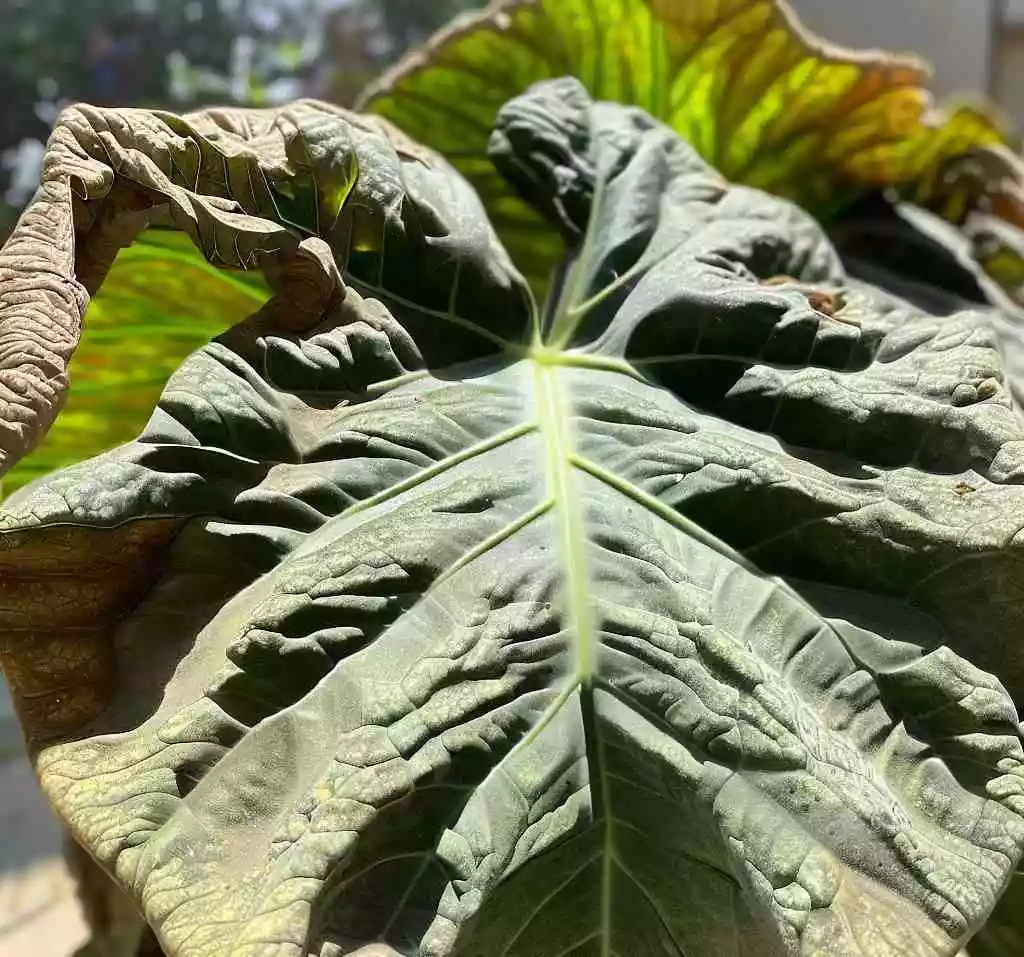
Lack of nutrients
A lack of certain nutrients can cause elephant ear plant leaves to droop because the plant is not getting enough nutrients to support its growth and health.
Nutrients are essential for a plant’s survival because they are used to produce energy and support metabolic processes. Here are some of the key nutrients that can cause the elephant ear plant leaves to droop:
- Nitrogen: Nitrogen is essential for the plant’s growth and the production of chlorophyll, which is responsible for photosynthesis. A lack of nitrogen can cause the leaves to turn yellow and droop.
- Phosphorus: Phosphorus is important for the plant’s root development and the production of flowers and fruits. A lack of phosphorus can cause the leaves to turn dark green and droop.
- Potassium is important for the plant’s water regulation and stress tolerance. A lack of potassium can cause the leaves to turn yellow and droop.
For example, suppose you have an indoor elephant ear plant not getting enough nitrogen. In that case, its leaves may start to turn yellow and droop because the plant cannot produce enough chlorophyll for photosynthesis.
Pest Infestation
Several common pests can cause elephant ear plant leaves to droop because they feed on their leaves or stems, disrupting the plant’s metabolic processes.
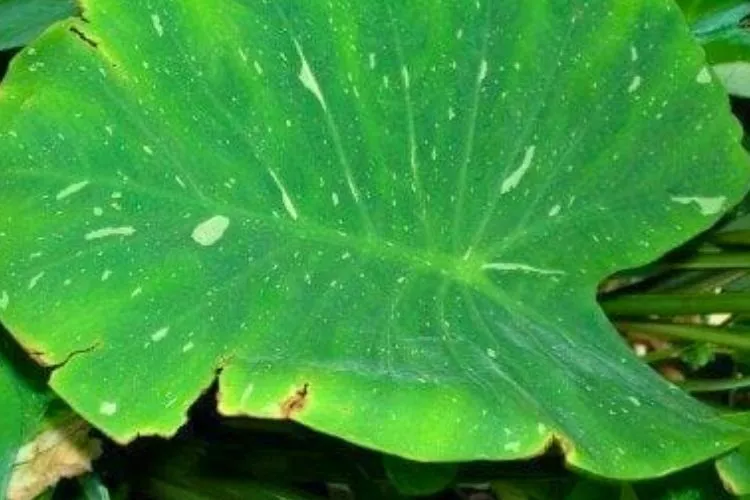
Common pests
Here are some of the key pests that can cause the elephant ear plant leaves to droop:
- Spider mites: Spider mites are tiny pests that feed on the plant’s leaves, causing them to turn yellow and droop. They also produce webbing that can cover the plant’s leaves.
- Mealybugs: Mealybugs are small, white insects that feed on the plant’s sap, causing the leaves to turn yellow and droop. They also produce a white, powdery substance on the leaves.
- Scale insects: Scale insects are small, flat insects that plant sap, causing the leaves to turn yellow and droop. They also produce a sticky substance that can attract other pests.
Identifying the Cause of Drooping Elephant Ear Plant
- Explain how to identify the specific cause of the plant’s drooping by examining the leaves and roots.
- Provide visual cues to look out for, such as yellowing or brown spots on the leaves, wilting or drooping leaves, and mushy or discolored roots.
- Compare the drooping plant to healthy elephant ear plants to determine the cause of the problem.
How to Fix a Drooping Elephant Ear Plant
This section will cover how to fix a drooping elephant ear plant. If you’ve noticed your elephant ear plant leaves drooping, it could be due to various issues such as watering problems, environmental factors, nutrient deficiency, or pest infestation.
Fortunately, you can take steps to correct these issues and revive your plant. Let’s have a look at those in detail:
Watering Issues
Watering issues can cause elephant ear plant leaves to droop, so let’s explore how to fix insufficient watering and overwatering issues with some easy-to-follow steps and tips:
Here are the steps you can take to fix insufficient watering
- Water the plant more frequently: If the soil feels dry to the touch, it’s time to water the plant. It on the environment, you may need to water the plant once or twice a week.
- Ensure the plant gets enough water: Make sure to water the plant until the water flows out of the drainage holes at the bottom of the pot.
And here are the steps you can take to fix overwatering
- Remove excess water: If the soil is too wet, remove the excess water by tipping the pot and allowing the water to drain out.
- Improve drainage: To prevent overwatering and root rot, ensure that the pot has drainage holes and that water can flow freely through the soil.
- Report: If all else fails, remove the plant, check the roots
How to Properly Water the Plant Based on the Cause of the Problem
Proper watering of an elephant ear plant depends on the cause of the problem. If the plant is suffering from insufficient watering, ensure it gets enough water by watering it once or twice a week.
If it’s overwatered, reduce the watering frequency and allow the soil to dry out before watering again.
Some other watering methods or tips that are best suited to the elephant plant include:
- Water deeply: When you water your elephant ear plant, make sure to reply to ensure that the water rites roots. This will help the plant stay hydrated and prevent the leaves from drooping.
- Use room temperature water: Cold water can shock the plant and cause the leaves to droop. So, it’s best to use room-temperature water when watering your elephant ear plant.
- Avoid wetting the leaves: Wetting the leaves of the plant can lead to fungal growth and other issues. So, it’s best to water the soil directly and avoid wetting the leaves.
- Use a watering can or hose with a gentle spray: When watering your elephant ear plant, avoiding a heavy stream of water can wash away the soil and damage the plant. Instead, use a watering can or hose with a gentle spray to water the plant evenly.
How to Improve Drainage to Prevent Overwatering and Root Rot
Improving drainage is essential to prevent overwatering and root rot. You can improve drainage by using a pot with drainage holes and ensuring water can flow freely through the soil.
Materials like perlite, sand, and vermiculite can improve drainage. These materials create pore spaces in the soil, allowing water to flow freely through the soil and preventing it from becoming waterlogged.
- Perlite: is a volcanic rock that has been heated and expanded. It is lightweight and porous, which makes it an excellent choice for improving soil drainage. Perlite can hold onto some water, but not too much, so it helps to create well-draining soil that doesn’t become too wet.
- Sand: is another material that can improve soil drainage. It comprises small, coarse particles that create pore spaces in the soil. However, it’s important to note that adding too much sand to the soil can drain too quickly and cause the soil to dry out too fast.
- Vermiculite: is a material that is often used in potting mixes to improve soil structure and drainage. It is made from expanded mica and has a spongy texture that can hold onto water and nutrients. Vermiculite helps to improve soil aeration and can help prevent soil from becoming too compacted.
Avoid using materials like peat moss and clay as they can retain water and worsen overwatering issues. It is possible to amend these materials by adding and blending some of the previously mentioned ones.
Environmental Factors
Environmental factors can also contribute to elephant ear plant drooping. Here are some tips for improving lighting and alleviating temperature stress:
Improving lighting
- Use a light meter to determine the amount of light your plant is receiving and adjust as necessary.
- Provide 12-16 hours of light per day if using artificial light.
- Use reflective surfaces around the plant to increase the amount of available light.
- Avoid sudden changes in lighting, such as moving the plant from a low-light to a high-light area.
- Place the plant in a bright, indirect light location.
- Use artificial light if necessary, such as a grow light.
- Rotate the plant regularly to ensure even growth.
- Try to keep the plant out of direct sunlight; this can and will scorch the leaves.
Alleviating temperature stress
- Maintain a consistent temperature range of 65-80°F (18-27°C)
- Use a humidifier to increase humidity levels.
- Avoid placing the plant around cold drafts, like near windows or doors. These drafts can do some wind damage as well as dry the plants out.
- Avoid exposing the plant to direct sunlight when it’s in the hottest part of the day.
- Use a fan to increase air circulation and prevent hot spots.
- Try to bunch your plants together to form a bit of a microclimate that encourages higher humidity levels.
- Keep the plant away from heating or cooling vents. This is similar to drafts; they can and will cause wind damage and dry them out.
Nutrient Deficiency
Nutrient deficiency can also cause elephant ear plant leaves to droop. Here are some recommendations for addressing this issue and tips on how to fertilize the plant properly based on the specific nutrient deficiency:
General Recommendations
- Examine the soil pH and identify which nutrient is deficient.
- Provide a balanced, slow-release fertilizer every 4-6 weeks during the growing season. Adjust accordingly if one or multiple nutrients are lacking and vice versa.
- Use a liquid fertilizer every 2-3 weeks during the growing season for faster results.
- Use a fertilizer specifically formulated for elephant ear plants to ensure proper nutrient balance.
- Avoid over-fertilizing, as this can lead to fertilizer burn and other issues.
Nutrient Specific Reccomendations
When it comes to a lack of a certain type of nutrient, adjusting to balance is as simple as purchasing a fertilizer based on that deficiency. For example:
- For nitrogen deficiency, use a fertilizer with a higher nitrogen content.
- For phosphorus deficiency, use a fertilizer with a higher phosphorus content.
- For potassium deficiency, use a fertilizer with a higher potassium content.
Pest Infestation
And here are some tips on how to treat the plant for pest infestations:
- For spider mites: Use a miticide or insecticidal soap, and keep the plant well-hydrated to prevent further infestation.
- For aphids: Use insecticidal soap or neem oil, and rinse the plant with water to remove any remaining pests.
- For scale insects: Use rubbing alcohol or insecticidal soap, and scrub the plant with a soft-bristled brush to remove the pests.
- For mealybugs: Use rubbing alcohol or insecticidal soap, and isolate the plant to prevent the infestation from spreading.
- For thrips: Use insecticidal soap or neem oil, and remove any affected leaves or flowers to prevent the infestation from spreading.
Preventing a Drooping Elephant Ear Plant
In this section, we’ll discuss some ways to prevent a drooping elephant ear plant from occurring in the first place. Taking the right preventative measures can help ensure that your plant stays healthy and thriving for years to come.
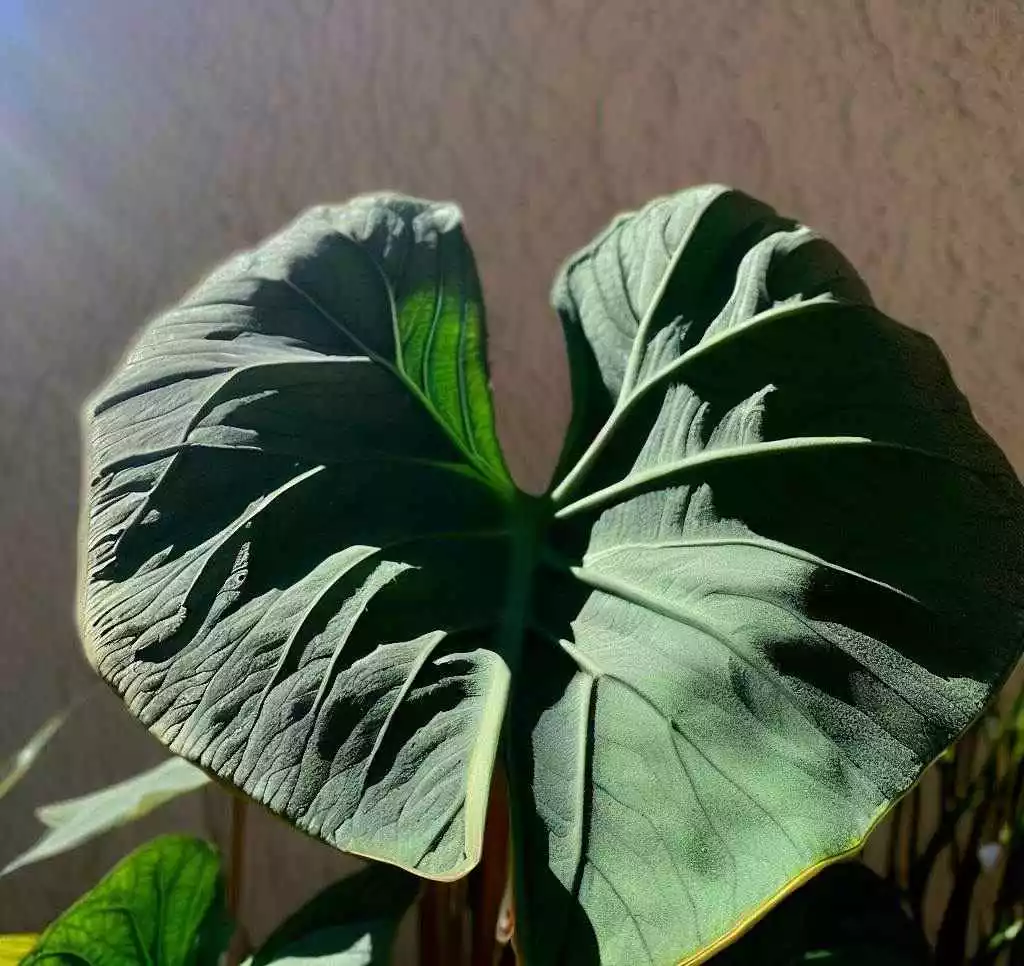
Regular maintenance
- Regularly checking the plant for signs of pest infestation.
- Removing dead or damaged leaves
- Repotting the plant every year or two to ensure that it has enough space to grow
- Keeping the plant clean by wiping down the leaves with a damp cloth or misting them with water
Proper watering technique
- Using a pot with drainage holes
- Watering the plant deeply, allowing the excess water to drain out
- Avoiding letting the plant sit in standing water
Proper lighting conditions
- Placing the plant near a window with filtered light
- Using artificial light sources such as grow lights
- Avoiding direct sunlight, which can scorch the leaves
Appropriate temperature
- Maintaining a temperature between 60 and 80 degrees Fahrenheit (15 to 27 degrees Celsius)
- Avoiding exposing the plant to sudden temperature changes, such as drafts from open windows or air conditioning vents
Appropriate soil conditions
- Using a high-quality potting mix that contains perlite or vermiculite to improve drainage
- Fertilizing the plant regularly to ensure that it has the nutrients it needs to thrive
Pest control measures
- Regularly inspecting the plant for signs of pest infestation
- Treating the plant promptly if an issue is detected using natural methods such as insecticidal soap or neem oil
- Avoiding exposing the plant to potential sources of infestation, such as other plants or contaminated soil.
Frequently Asked Questions (FAQs)
How often should I water my elephant ear plant?
Watering frequency depends on factors such as temperature and humidity, but generally, water when the top inch of soil feels dry.
How much light does an elephant ear plant need?
Elephant ear plants prefer bright, indirect light but avoid direct sunlight.
Can I propagate my elephant ear plant?
Yes, you can propagate elephant ear plants through division or stem cuttings.
How do I fertilize my elephant ear plant?
Fertilize with a balanced, water-soluble fertiliser every 2-4 weeks during the growing season.
Conclusion:
In conclusion, preventing elephant ear plant drooping requires proper watering, lighting, temperature, soil conditions, regular maintenance, and pest control.
By following these preventative measures, your plant can thrive and avoid drooping. We hope this guide has been helpful. You can read about similar topics here on our website. Check back again soon for more.


